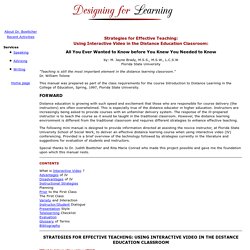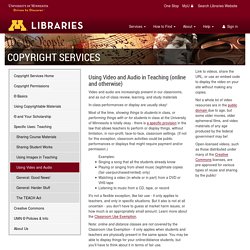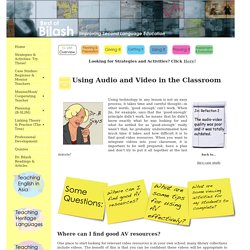

iMotion on the App Store. Six reasons to use video in the ELT classroom. In the first of a short series of posts, Unlock author Lewis Lansford looks at why we should be using video in the classroom. 1.

Video speaks to Generation V Skype was released in 2003 and YouTube followed in 2005. The iPad was unveiled in 2010. Internet usage has increased from 16% of the world’s population in 2005 to about 40% today (nearly 80% in developed countries). My own kids – aged 8 and 10 – routinely communicate with their grandparents via video chat. 3. 4. 5. Video can also provide a good reference point for critical thinking: for example, in considering advertisements, learners can develop the skills of considering motivation, whether or not supporting details are valid, and so on. 6.Video provides a good model for learner output After we’ve thoroughly exploited a video as a language input, we can then use it as a model for learner output.
About the author: Lewis Lansford+ Lewis Lansford is an English language teaching materials writer and developer, and a teacher trainer. Strategies for Effective Teaching: Using Interactive Video in the Distance Education Classroom. All You Ever Wanted to Know before You Knew You Needed to Know by: M.

Jayne Brady, M.S.S., M.S.W., L.C.S.W Florida State University "Teaching is still the most important element in the distance learning classroom. " Dr. This manual was prepared as part of the class requirements for the course Introduction to Distance Learning in the College of Education, Spring, 1997, Florida State University. Distance education is growing with such speed and excitement that those who are responsible for course delivery (the instructors) are often overwhelmed. The following mini manual is designed to provide information directed at assisting the novice instructor, at Florida State University School of Social Work, to deliver an effective distance learning course when using interactive video (IV) conferencing. Special thanks to Dr. Using Video and Audio in Teaching (online and otherwise) Video and audio are increasingly present in our classrooms, and as out-of-class review, learning, and study materials In-class performances or display are usually okay!

Most of the time, showing things to students in class, or performing things with or for students in class at the University of Minnesota is totally okay - there is a specific provision in the law that allows teachers to perform or display things, without limitation, in non-profit, face-to-face, classroom settings. (If not for this exception, classroom activities could be public performances or displays that might require payment and/or permission.) Examples: Singing a song that all the students already know Playing or singing from sheet music (legitimate copies (fair use/purchased/rented) only) Watching a video (in whole or in part) from a DVD or VHS tape Listening to music from a CD, tape, or record It's not a flexible exception, like fair use - it only applies to teachers, and only in specific situations.
Online media. Audio & VIdeo in the Classroom. Where can I find good AV resources?

One place to start looking for relevant video resources is in your own school; many library collections include videos. The benefit of this is that you can be confident these videos will be appropriate to show students (in terms of their content) and you will more easily be able to see where these videos fit into the curriculum.
On the other hand, however, keeping these video resources up-to-date can sometimes be a challenge, so this must be kept in mind when deciding on whether or not the resources are suitable. Local libraries and local language community organizations may also have video resources that can be used in the classroom. In addition, the internet can be an excellent place to look. What are some tips for using AV effectively? First and foremost, the teacher must always preview the audio/video before presenting it to students. For a lesson involving AV to be a valuable use of class time, students need to be engaged the whole time.
Teaching-with-Technology - Using Audio-Visual in education. This page provides links and ideas for ways to use, create and watch audio visual presentations in the classroom.

It includes ideas for audio, video for the classroom and video for professional development and using images. Or you can mash audio, video and images all together by using these tools. Another challenge for teachers is to discourage students from using copyrighted music for the creation of soundtracks for videos and digital stories. Here are some links to a range of sites where students can freely use music to add to their creations.
Audio: What is a Podcast? ITunes, a free download for both Apple or Windows computers check out more about what ITunes can do hereIPod in Education: is a useful site for teachers who are using IPods in K-12education. Create, find and share podcasts to the world. PodBean is a podcatcher, podcast creator and a podcast searcher. Free Online Video Editor and Maker.